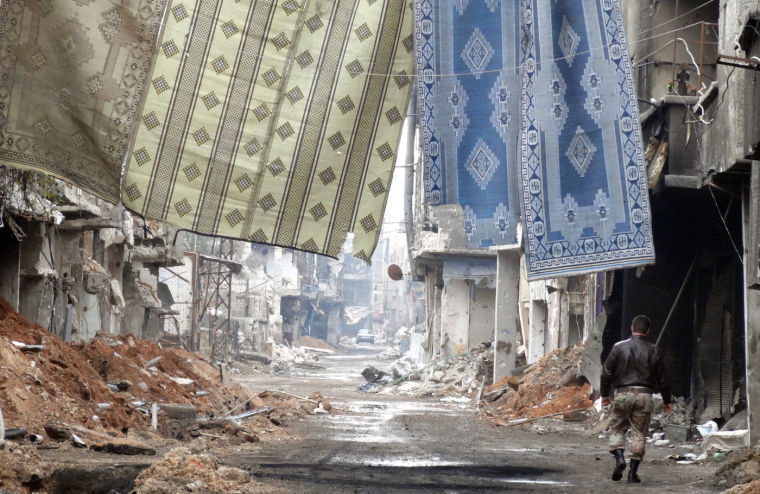A wider warzone
A Syrian regime militiaman walks beneath anti-sniper screens near the front line in Tadamon, Syria, Jan. 14.
April 15, 2014
In the years since protests initiated in 2011, Syria has become host to a great number of factions vying for economic and political power within the embattled nation.
Support for rebel factions can be seen originating from countries both near and far—including the United States, Saudi Arabia, Qatar, Jordan, Turkey, Great Britain and France.
Of course, one man’s freedom fighter is another man’s terrorist, and it is clear that the Syrian Civil War has become a globalized conflict propped up by proxy financing rather than the domestic clashes that the given name would imply.
On Feb. 12 of this year, the United Nations Human Rights Council released its “Report of the independent international commission of the inquiry on the Syrian Arab Republic,” which found that one fifth of Lebanon’s population can be attributed to Syrian refugees.
Reuters reported expenses exceeding $5 billion for the continued operations of refugee camps within Jordan alone, and the Zaatari camp has become one of largest “cities” within the kingdom.
USAID boasts of its status as the largest monetary contributor to humanitarian efforts in Syria on its official fact sheet, but their contributions of 1.8 billion since the beginning of the conflict are less than 40 percent of the estimated costs of maintaining refugee camp operations for two years just in Jordan.
The Obama administration approved of $260 million to be used for “non-lethal assistance,” according to the State Department’s “The Syrian Crisis: U.S. Assistance and Support for the Transition Fact Sheet.”
Of this $260 million, $25 million was set aside for a program sponsored through the Conflict Stabilization Office to deliver cameras, encrypted radios, laptops equipped with internet-control circumvention software, and phones, according to an article from the Guardian.
Still, the United States is not alone in its efforts to covertly and overtly influence political stability within Syria.
Assad’s forces have received Russian UAVs along with, according to a Middle East security source “armored vehicles, surveillance equipment, radars, electronic warfare systems, spare parts for helicopters, and various weapons including guided bombs for planes” since December, Reuters reported. The UAVs have been operated by Russian intelligence elements to provide around the clock logistical support.
Leaked tapes ahead of Turkey’s March 30 elections have damaged Prime Minister Erdogan’s reputation and pointed to a possible false flag operation in order to pull NATO into a conflict with Syria.
The leaked tapes were described as an act of war and also said to be taken out of context.
According to Reuters, the head of Turkey’s intelligence agency, Hakan Fidan, is purported to have encouraged the attack in the leaked tapes, supposedly saying, “Now look, my commander, if there is to be justification, the justification is, I send four men to the other side. I get them to fire eight missiles into empty land. That’s not a problem. Justification can be created.”
On the opposite side of the spectrum, Iran remains a major player in financing and providing military support for Assad’s regime.
This aid, including weapon shipments, is also delivered to the Jaysh al-Sha’bi militia, who “conducted unilateral and joint operations with Syrian military and security elements against the Syrian opposition,” according to the U.S. Treasury statement reported on by CNN.
Iran has been implicated in the act of funding and training the Jaysh al-Sha’bi militia, along with Hezbollah forces.
In response to Assad’s recent successes in the Syrian Civil War, Turkey, Qatar, Saudi Arabia, Jordan and the United States have established a “rat-line” to covertly funnel weapons into rebels’ hands.
There exists an operation room in Jordan that supplies rebel factions with training in addition to arms, ammunition and antitank weapons at the rate of 380 fighters per month, as reported by an article from The New York Times.
The West has acted too late. With the current crisis in Ukraine, European and other NATO forces are being held ready for any possible conflicts with Russian aggression and no meaningful resources can be devoted to a quick topple of the Assad regime.
Instead, the West’s reluctance to act in fear of recreating another Iraq or Afghanistan has ironically produced a quagmire of similar sorts.
If the world truly wanted to see an end to the conflict in Ukraine, NATO would have acted sooner in a way similar to the air campaign that so quickly brought down Gadhafi in Libya.
Unfortunately, millions are left displaced because the West gave Assad an unreasonable amount of slack with regards to human rights violations.
In Syria, United States foreign policy has failed all, and the besieged Syrian people will continue to pay the brutal price.
– Bryan Allen is a junior political science major from Puyallup. He can be contacted at 335-2290 or by [email protected]. The opinions expressed in this column are not necessarily those of the staff of The Daily Evergreen or those of Student Publications.









